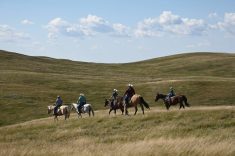Last year, a record-breaking cold Prairie winter followed by a snowy spring and a shortage of good-quality forage left a lot of overwintered beef cows in dire body condition by the time they calved. Many didn’t recover during the months leading up to the breeding season. As a result, many cows were not prepared to be bred, remained open and were most likely culled. It’s a good les- son that post-calving cows need good nutrition so they are in the best shape for good reproduction in order to remain a profitable member of any cow-calf operation.
Good post-calving nutrition is really a continuation of good over- winter feeding programs. They should maintain a visible cows’ Body Condition Score of 5-6 by calving, which should be carried to the end of the upcoming breeding season.
This level of BCS has been proven by research to return a higher proportion of fertile beef cows compared to thin cows (with a BCS below 4.0); to a strong estrus 80 to 90 days postpartum, resulting in higher conception rates. Next year’s calves are born earlier in a desired short calving season, which also results in higher fall weaning weights (In some cases 23 to 25 kg higher).
Read Also

Harvest wraps up and fall work begins
At the Eppich famly ranch in western Saskatchewan, the fall harvest was successful with few breakdowns, cows and calves have been sorted and a new tractor has arrived
[RELATED] Canadian Cattlemen: Predicting cattle performance is not a simple science
This means most fresh cows with a decent BCS, producing 10 to 15 litres of milk for their calf, require forage-based diets of about 58 to 62 per cent TDN (total digestible nutrients) and about 11 to 12 per cent protein to maintain good body condition until the breeding season. Given that a mature gestating beef cow (500 to 600 kg or about 1,200 pounds) consumes about 2.0 to 2.25 per cent of her body weight (dm basis) or about 10 to 13 kg of dry-based feed.
Many experienced beef producers I know often estimate the total amount of feed they will need for the winter. The first feed their early- mid-gestation cows the lower-quality feeds such as straw-based diets, or fair-quality grass-type hays, when cow requirements are more modest. As the calving season approaches, they implement more-nutritious saved feeds such as legume/alfalfa hays and ensiled (higher-energy) feeds. Once the cows calve and their nutrient requirements are at their highest point, depending on forage quality, grain and protein are supplemented.
A producer experience
For example, a friend runs a 200 head herd of purebred Red Angus. His first-calf heifers start calving Feb. 15 and the rest of the mature brood cows calve two weeks later. Most have maintained an adequate 5 to 6 BCS by calving, because he feeds an overwinter TMR of 10 kg of barley silage and 11 to 12 kg alfalfa/grass hay.
Once the first cows calve, he feeds them up to one to two kg of grain most days, with an extra kg or so when the windchill dips below -18 C. As the weather gets warmer and the cow herd is past 60 days postpartum, grain feed- ing is eliminated, less barley silage is fed and replaced by lower-protein grass hay. This prevents cows from getting too fat.
[RELATED] Canadian Cattlemen: Calving records will be especially valuable in 2022
His post-calving total mixed ration also contains 100 g per head per day of an 18 per cent calcium, nine per cent phosphorus premix medicated with 250 mg per had per day of monensin. These respective macrominerals (calcium, phosphorus, and two per cent magnesium) compliment the macromineral levels found in his barley silage/alfalfa-grass forages.
In addition, trace mineral requirements of his nursing beef cows nearly double after the start of the winter season and are supplemented with heightened levels of copper (3,000 mg/kg), zinc (12,000 mg/kg) and selenium (3.0 mg/kg). Most are formulated in this mineral in “chelated” or more bio-available forms for their superior absorption and retention properties. Essential A, D and E are also equivalently fortified.
I agree with his attention to mineral detail. For example, a lack of dietary copper has been shown to be responsible for reduction in first-service conception rates and early embryonic survival in mature beef cows and first-calf heifers. Deficient cows may actually show normal estrus behaviour, but normal ovulation does not occur and may lead to future estrus retardation. Erratic estrus cycles may be caused by antagonistic minerals such as molybdenum, that tie up dietary copper.
Adding a good mineral/vitamin premix to a well-balanced TMR that also contains adequate dietary energy and protein for cows after calving helps maintain their body condition/fertility by the time the breeding season arrives. Good nutrition promotes a quick return to active reproduction, successful breeding and a cow pregnant with a new calf.
















